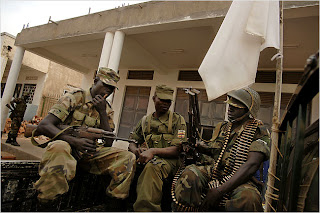The Ugandan government and the Lord’s Resistance Army are now negotiating for peace, and the next item on the agenda is the conditions for return and reintegration of the rebel force. In addition to fighters numbering at least a thousand, there are thought to be thousands of porters, cooks, wives and children.
In a new Survey of War Affected Youth research brief, my co-researchers and I challenge some deeply-held assumptions about the effects of war on youth and argue for changes to the demobilization, disarmament and reintegration (DDR) status quo, namely:
- Careful and cautious use of reinsertion packages for former combatants, introduced alongside larger, broad-based programs for communities and youth in general
- Scaled-up educational and economic programs available to the poorest and most vulnerable youth
- Introduction of new programs offering specialized care to youth with war injuries, serious emotional distress, and family/community conflicts
- An end to the practice of targeting youth for their war experiences (e.g. abduction status) rather than their needs
- Special attention to the special educational and community reintegration challenges facing young women, mothers, and girls
- The need for rigorous evaluations of alternative reintegration programs and strategies–what works, for whom, and why?
Previous SWAY reports are available here. Previous blog postings on the hype and reality around child soldiers are available here and here.
Upcoming SWAY Presentations
Presentations of SWAY Phase II results (and some of the reintegration recommendations from the Research Brief) will be held across Uganda over the coming two weeks.
- Kitgum: 29 Nov 2007, 9am, OCHA coordination meeting (RSVP to Willy Nalwabe)
- Gulu: 3 Dec 2007, 3pm, UN headquarters (RSVP to Caroline Aloyo)
- Kampala: 5 Dec 2007, 10am, UNICEF headquarters (RSVP to Stephanie Schwarz)
Background to the conflict
Unfortunately, the research brief provides almost no background on the conflict in northern Uganda. If you’re interested in learning more, the Wikipedia entry is not bad, but I’d recommend these free online sources for more in depth history.
- A 1997 report to USAID by Robert Gersony was one of the first comprehensive reviews of the LRA conflict
- This 2002 issue of Accord, edited by Okello Lucima, features writings by Acholi journalists, leaders and historians
- Tim Allen, has a brief but comprehensive history in his 2005 assessment of the International Criminal Court’s intervention
- Makerere University’s Refugee Law Project has several publications, including this working paper on the causes and consequences of the violence in northern Uganda
- Jeannie Annan and I have published an account of the Nature and Causes of Child Soldiering and our SWAY Phase I report on the impacts of the war on young men and boys
Get involved
For progress updates on the peace and reconciliation process, as well as ideas for how you can get involved, you can visit Resolve Uganda’s website and subscribe to their RSS feed.
Finally, if you’re interested in contributing to peace and recovery in northern Uganda, Jeannie and I have started two small charities. One supports several youth groups in northern Uganda, and we have just recently started a fund to help a friend rebuild her organization that supports persons and orphans living with AIDS after damage by floods. Both offer tax receipts to US and Canadian taxpayers.

